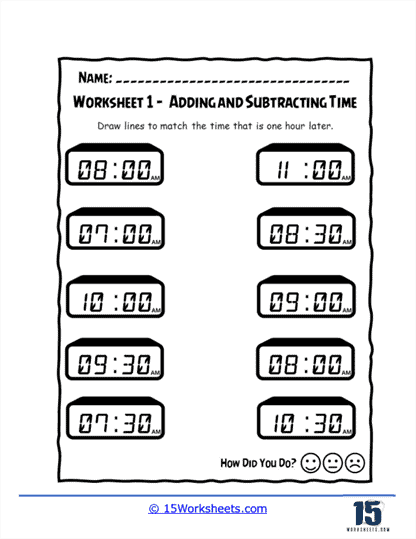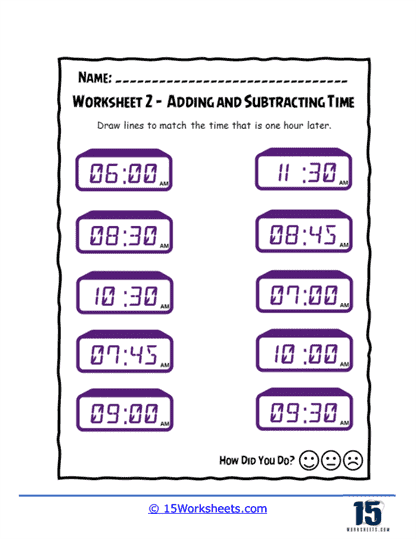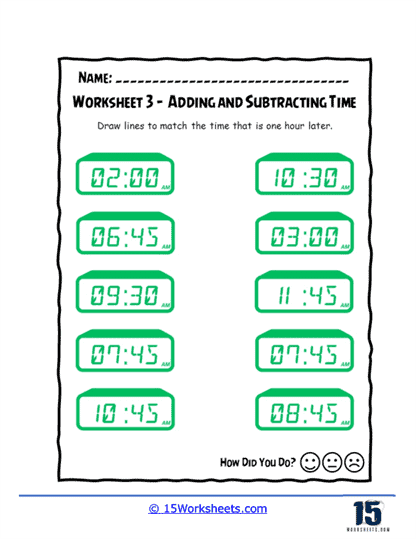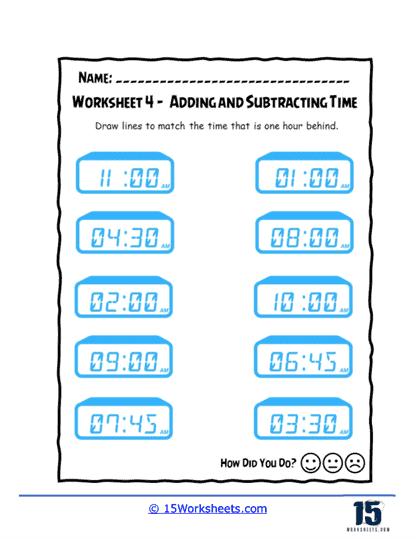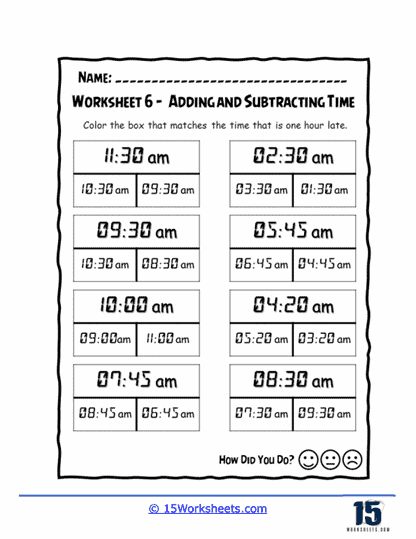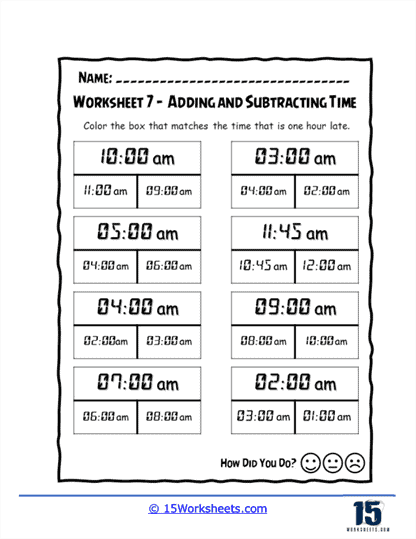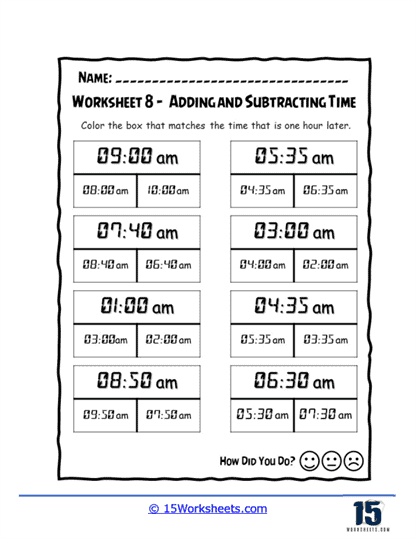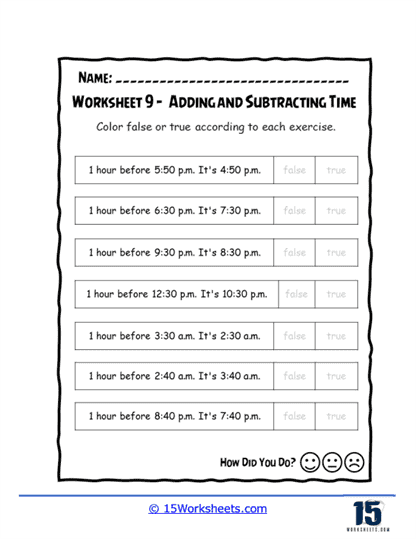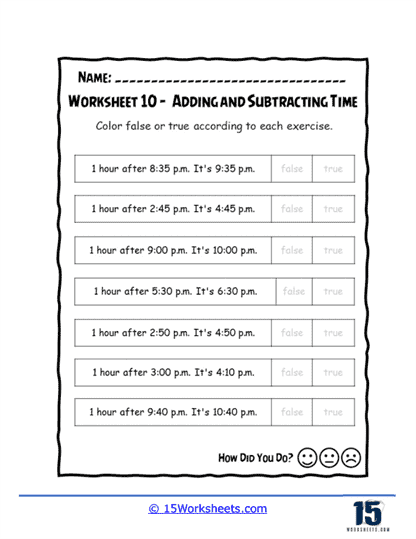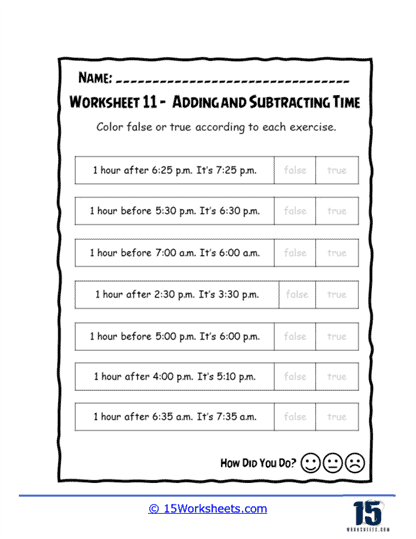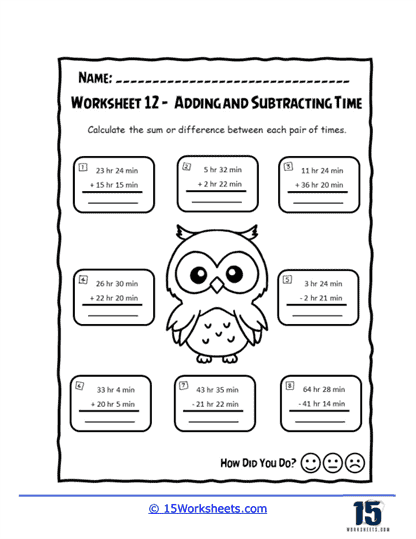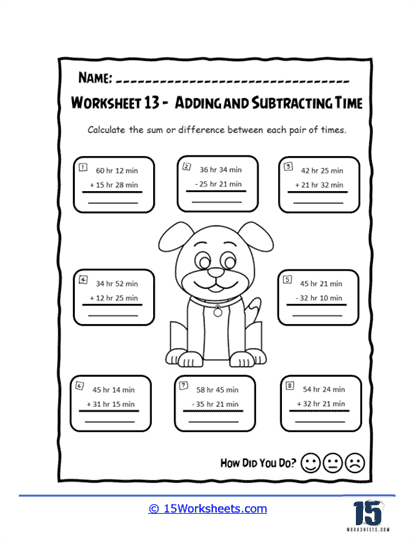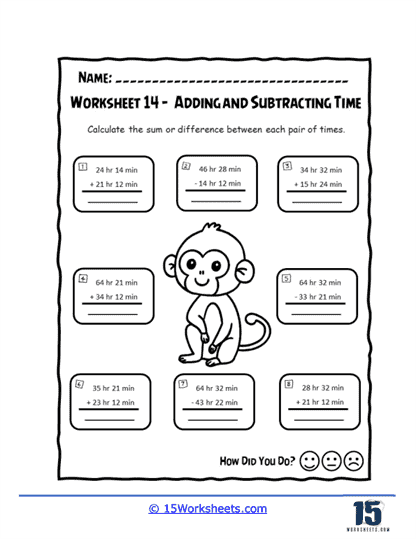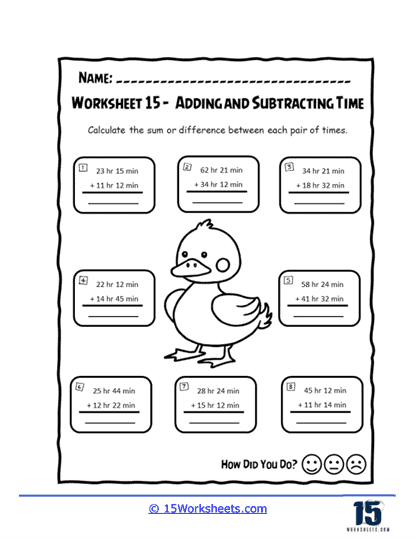Adding and Subtracting Time Worksheets
About These 15 Worksheets
Adding and subtracting time worksheets will help students master the concepts of time calculation. These worksheets guide students through various exercises to practice adding and subtracting hours, minutes, and seconds. By engaging with these worksheets, students improve their ability to manage time effectively, enhance their arithmetic skills, and develop critical thinking abilities.
Mathematical Skills Explored
One of the primary skills these worksheets focus on is the ability to accurately read and interpret clocks and calendars. Students must understand the format of hours, minutes, and seconds on both analog and digital clocks, as well as the structure of days, weeks, months, and years on calendars. This foundational knowledge is essential for performing any time-related calculations.
Another significant skill explored in these worksheets is the concept of time intervals. Students learn to determine the duration between two given times, which requires a solid understanding of the passage of time and the ability to break down hours and minutes into smaller, more manageable segments. This skill is particularly important for solving real-world problems, such as figuring out how much time has passed between events or how much time remains until a future event.
Adding and subtracting time also involves complex arithmetic operations. Students practice adding and subtracting hours and minutes, which can often lead to situations where they need to carry over or borrow time. For instance, when adding times that sum to more than 60 minutes, students must convert these minutes into an additional hour. Conversely, when subtracting and needing to borrow, they must convert one hour into 60 minutes. This aspect of time calculation reinforces their understanding of regrouping in arithmetic, a critical skill for more advanced math.
Exercises on These Worksheets
These worksheets feature a variety of problems designed to address different aspects of time manipulation and enhance students’ understanding of temporal arithmetic. One common type of problem involves straightforward addition and subtraction of time intervals. These exercises might present students with two times and require them to calculate the sum or difference, such as determining the time 45 minutes after 2:15 PM or finding out how much time has elapsed between 8:30 AM and 11:45 AM. These basic problems help students practice the mechanics of adding and subtracting hours and minutes.
Another type of exercise found on these worksheets involves word problems that place time calculations within real-life contexts. For example, a problem might describe a scenario where a student starts their homework at 4:00 PM and spends 1 hour and 35 minutes completing it, asking what time they finish. These word problems require students to apply their time addition and subtraction skills in practical situations, fostering their ability to solve real-world problems and understand the relevance of their calculations.
Worksheets also include problems that require converting between different units of time. For instance, students could be asked to convert 2 hours and 45 minutes into minutes, or vice versa, converting 150 minutes into hours and minutes. These exercises help students become adept at handling time in various formats and understanding the relationships between different time units.
More advanced worksheets present problems involving the concept of carrying over and borrowing. For example, students might need to add 75 minutes to a given time, requiring them to convert excess minutes into hours. Similarly, they might need to subtract a larger minute value from a smaller one, necessitating borrowing from the hour component. These problems reinforce their understanding of the base-60 system used in time calculations and enhance their arithmetic skills.
The Benefits Of These Worksheets
Learning how to calculate adding and subtracting time offers numerous educational and cognitive benefits. It enhances arithmetic skills, particularly in the context of base-60 calculations, which are unique to time. This practice reinforces students’ understanding of fundamental mathematical operations such as addition and subtraction, as well as concepts like regrouping and borrowing. By working with time, students become more proficient in handling complex arithmetic tasks, which translates into better overall mathematical competence.
Mastering time calculations improves problem-solving abilities. When students engage with time-related problems, they must often think critically and logically to arrive at the correct answers. These problems frequently involve multiple steps and require careful consideration of each component (hours, minutes, and sometimes seconds). This process fosters analytical thinking and helps students develop a systematic approach to solving complex problems, a skill that is invaluable in many academic and professional fields.
Learning to add and subtract time promotes better time management and organizational skills. As students become adept at calculating time intervals and durations, they gain a clearer understanding of how time passes and how to allocate it effectively. This awareness is crucial for planning schedules, meeting deadlines, and managing various tasks efficiently. These time management skills are not only essential for academic success but also for personal and professional life.
Real World Application Of This Skill
In the real world, the ability to calculate adding and subtracting time is used in a wide range of practical situations. For instance, in the workplace, professionals often need to schedule meetings, manage project timelines, and coordinate with colleagues in different time zones. Accurate time calculations ensure that tasks are completed on time and that communication across different locations is synchronized. This skill is particularly important in fields such as project management, event planning, and transportation, where precise timing is critical.
In everyday life, individuals use time calculation skills for various personal activities. Whether it’s planning a trip, cooking a meal, or organizing a social event, knowing how to add and subtract time helps individuals allocate sufficient time for each task and avoid conflicts. For example, if someone needs to prepare a three-course meal with specific cooking durations for each course, they must calculate the start times and sequence the preparation steps to ensure everything is ready simultaneously.
Example Problem – You start reading a book at 3:15 PM and read for 2 hours and 45 minutes. What time do you finish reading?
Step-by-Step Solution
1. Identify the start time and the duration to add
Start time: 3:15 PM
Duration: 2 hours and 45 minutes
2. Add the hours first
Start with 3:15 PM
Add 2 hours
3:15 PM + 2 hours = 5:15 PM
3. Add the minutes next
Start with 5:15 PM
Add 45 minutes
5:15 PM + 45 minutes
4. Break down the minute addition
Adding 45 minutes to 5:15 PM:
5:15 PM + 45 minutes = 5:15 PM + 45 minutes (30 minutes to get to 5:45 PM and 15 more minutes to reach 6:00 PM)
5. Combine the results
The final time after adding 2 hours and 45 minutes to 3:15 PM is 6:00 PM
So, you finish reading at 6:00 PM.

